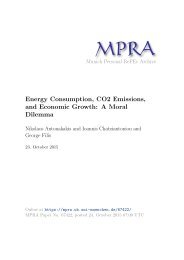MPRA
n?u=RePEc:pra:mprapa:75444&r=env
n?u=RePEc:pra:mprapa:75444&r=env
You also want an ePaper? Increase the reach of your titles
YUMPU automatically turns print PDFs into web optimized ePapers that Google loves.
mand, conventional plants start to produce electricity. Maintenance of such systems<br />
is costly. For Germany, amount of EUR 590 million in 2006 was calculated by Erdmann<br />
(2008). The use of fossil fuels is relatively easy and cheap only in case of<br />
long-term balancing (i.e. days or week notice).<br />
• Transmission of surplus from one location to another, this requires good interconnection<br />
between locations. This goes back to the development of the grid and also<br />
may require good collaboration between the states. In addition, it will increase the<br />
grid balancing costs.<br />
• Demand response, so when RES expected to produce low volume of electricity, large<br />
industrial and commercial customers are paid by the grid operator to lower their<br />
consumption of electricity by switching off machines and/or air conditioning etc.<br />
The amount of payment must be properly calculated, nevertheless this method is<br />
costly and difficult to implement. This method is relatively easy to implement in<br />
medium-term notice (i.e. hours).<br />
• Energy storage, surplus of produced RES-E is stored and when RES-E producer<br />
cannot meet the demand stored electricity is fed into the grid. Probably the best<br />
option in short notice (i.e. seconds to minutes).<br />
The latter option is promising because prices for batteries have been falling.<br />
For<br />
example, prices of electric vehicle batteries are steadily decreasing.<br />
The average cost<br />
per kWh fell from some 1000 $ in 2010 (EUR 757.57, exchange rate is 1.32, which is<br />
average monthly rate for 2010) to some 390 $ 9 in 2015 (EUR 354.55, exchange rate is<br />
1.10, which is average monthly rate for 2010). The decrease is caused by technological<br />
improvements as well as economies of scale. This is also driven by increasing demand for<br />
electric vehicles. There are two types of storage: so-called ”behind the meter” and the<br />
grid-scale storage.<br />
9 See prev. note<br />
9








